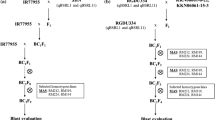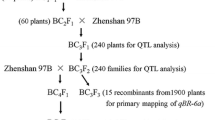Abstract
The indica rice variety Dee Geo Woo Gen (DGWG) was the source of the semidwarf gene (SD1) which played an important role in the Green Revolution. In the present study, resistance (R) genes to the US race (isolate) IB54 of Magnaporthe oryzae, causal agent of rice blast disease, was investigated. Two recombinant inbred line mapping populations, consisting of 175 and 224 individuals derived from crosses of DGWG with the straw hull weedy rice type PI653435 (AR-2001-1135; S population) and the black hull type PI653419 (MS-1996-9; B population), respectively, were used for mapping blast R genes and quantitative trait loci (QTLs). Two high-resolution linkage maps with 6,513 (S population) and 14,382 (B population) single nucleotide polymorphic markers derived from genotyping-by-sequencing data were used to map R genes. Two partial resistance QTLs, qBR1.1 and qBR6.1, and one major resistance QTL, qBR11.1, were identified in the B population. One partial resistance QTL, qBR6.1, and one major resistance QTL, qBR11.1, were confirmed with the S population. The total phenotypic variation of three resistance QTLs was 51 %, ranging from 1.12 to 47.62 %, in the B population. All three resistance QTLs were localized to relatively small genomic regions. The major resistance QTL, qBR11.1, was mapped to a 129-kb region on chromosome 11 near nine known blast R genes. Within this 129-kb region, three genes encoding putative nucleotide-binding site and leucine-rich repeat (LRR) disease resistance proteins and three genes encoding WRKY transcription factors WRKY61, WRKY63, and WRKY41 were identified as candidate genes of qBR11.1 and tentatively designated as Pi66(t). Identification of blast R genes in DGWG should help continued deployment of useful genes for improving crop productivity and resistance to rice blast disease.


Similar content being viewed by others
References
Ballini E, Morel JB, Droc G, Price A, Courtois B, Notteghem JL, Tharreau D (2008) A genome-wide meta-analysis of rice blast resistance genes and quantitative trait loci provides new insights into partial and complete resistance. Mol Plant Microbe Interact 21:859–868
Belkhadir Y, Subramaniam R, Dangl JL (2004) Plant disease resistance protein signaling: NBS-LRR proteins and their partners. Curr Opin Plant Biol 7:391–399
Broman KW, Sen S (2009) A Guide to QTL Mapping with R/qtl. Springer, Berlin, ebook
Elshire RJ, Glaubitz JC, Sun Q, Poland JA, Kawamoto K, Buckler ES, Mitchell SE (2011) A robust, simple genotyping-by-sequencing (GBS) approach for high diversity species. PLoS ONE 6(5):e19379
Haley CS, Knott SA (1992) A simple regression method for mapping quantitative trait loci in line crosses using flanking markers. Heredity 69:315–324
Inukai T, Nelson RJ, Zeigler RS, Sarkarung S, Mackill DJ, Bonman JM, Takamure I, Kinoshita T (1994) Allelism of blast resistance genes in near-isogenic lines of rice. Phytopathology 84:1278–1283
Jia Y, Liu GJ (2011) Mapping quantitative trait loci for resistance to rice blast. Phytopathology 101:176–181
Jia Y, Martin R (2008) Identification of a new locus, Ptr(t), required for rice blast resistance gene Pi-ta-mediated resistance. Mol Plant Microbe Interact 21:396–403
Jia Y, Lee F, McClung A (2009) Determination of resistance spectra to US races of Magnaporthe oryzae causing blast in a recombinant inbred line population. Plant Dis 93:639–644
Lee S, Wamishe Y, Jia Y, Liu G, Jia MH (2009) Identification of two major resistance genes against race IE-1k of Magnaporthe oryzae in the indica rice cultivar Zhe733. Mol Breed 24:127–134
Liu Y, Liu B, Zhu X, Yang J, Bordeos A, Wang G, Leach JE, Leung H (2013) Fine-mapping and molecular marker development for Pi56(t), a NBS-LRR gene conferring broad-spectrum resistance to Magnaporthe oryzae in rice. Theor Appl Genet 126:985–998
Liu Y, Qi X, Vigueira CC, Caicedo AL, Jia YL, Gealy RD, Olsen KM. (2014) QTL mapping using Genotyping-by-Sequencing shed light on the parallel evolution of weedy rice: more than one way to evolve a weed. Mol Ecol (in preparation)
McCouch SR (2008) Gene nomenclature system for rice. Rice 1:72–84
Moytri R, Jia YL, Richard DC (2012) Structure, function, and co-evolution of rice blast resistance genes. Acta Agron Sin 38:381–393
Rybka K, Miyamoto M, Ando I, Saito A, Kawasaki S (1997) High resolution mapping of the indica-derived rice blast resistance genes. II. Pi-ta 2 and Pi-ta and a consideration of their origin. Mol Plant Microbe Interact 10:517–524
Sasaki A, Ashikari M, Ueguchi-Tanaka M, Itoh H, Nishimura A, Swapan D, Ishiyama K, Saito T, Kobayashi M, Khush GS, Kitano H, Matsuoka M (2002) Green revolution: a mutant gibberellin-synthesis gene in rice. Nature 416:701–702
Sen S, Churchill GA (2001) A statistical framework for quantitative trait mapping. Genetics 159:371–387
Sharma TR, Rai AK, Gupta SK, Vijayan J, Devanna BN, Ray S (2012) Rice blast management through host-plant resistance: retrospect and prospects. Agric Res 1:37–52
Spielmeyer W, Ellis MH, Chandler PM (2002) Semidwarf (sd-1), “green revolution” rice, contains a defective gibberellin 20-oxidase gene. Proced Natl Acad Sci USA 99:9043–9048
Tabien RE, Li Z, Paterson AH, Marchetti MA, Stansel JW, Pinson SRM (2000) Mapping of four rice blast resistance genes from ‘Lemont’ and ‘Teqing’ and evaluation of their combinatorial effect for field resistance. Theor Appl Genet 101:1215–1225
Valent B, Chumley FG (1994) A virulence genes and genetic instability. In: Leong SA, Teng PS, Zeigler RS (eds) Rice blast disease. CAB International, Wallingford, pp 111–153
Wu KL, Guo ZJ, Wang HH, Li J (2005) The WRKY family of transcription factors in rice and Arabidopsis and their origins. DNA Res 12:9–26
Yuan B, Zhai C, Wang W, Zeng X, Xu X, Hu H, Lin F, Wang L, Pan Q (2011) The Pik-p resistance to Magnaporthe oryzae in rice is mediated by a pair of closely linked CC-NBS-LRR genes. Theor Appl Genet 122:1017–1028
Acknowledgments
We thank Marcos André Nohatto, Michael Lin, and Tracy Bianco for their excellent technical support. This project was funded in part by the National Science Foundation Plant Genome Research Program (NSF award IOS-1032023). The US Department of Agriculture is an equal opportunity provider and employer.
Author information
Authors and Affiliations
Corresponding author
Electronic supplementary material
Below is the link to the electronic supplementary material.
11032_2015_256_MOESM1_ESM.tif
Supplementary Fig. 1 Logarithm of odds (LOD) curves of R QTLs identified using B and S population. a LOD curves of three resistance (R) QTLs identified using B population. The significant threshold of LOD is 3.65 as indicated by the red dotted line. The LOD peak value is 8.58 for qBR1.1 on chromosome 1, 7.02 for qBR6.1 on chromosome 6, and 57.5 for qBR11.1 on chromosome 11. b LOD curves of two R QTLs identified using S population. The significant threshold of LOD is 3.67 as indicated by the red dotted line. The LOD peak value is 8.72 for qBR6.1 on chromosome 6 and 24.8 for qBR11.1 on chromosome 11 (TIFF 95 kb)
11032_2015_256_MOESM2_ESM.tif
Supplementary Fig. 2 Disease reactions of three parental lines, DGWG, RR20, and RR9, to blast race IB54. DGWG is resistant to IB54, while RR20 is susceptible and RR9 is partially resistant (TIFF 215 kb)
Rights and permissions
About this article
Cite this article
Liu, Y., Qi, X., Young, N.D. et al. Characterization of resistance genes to rice blast fungus Magnaporthe oryzae in a “Green Revolution” rice variety. Mol Breeding 35, 52 (2015). https://doi.org/10.1007/s11032-015-0256-y
Received:
Accepted:
Published:
DOI: https://doi.org/10.1007/s11032-015-0256-y




